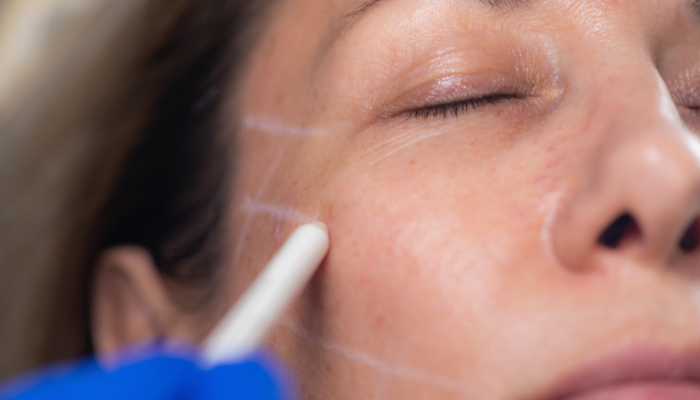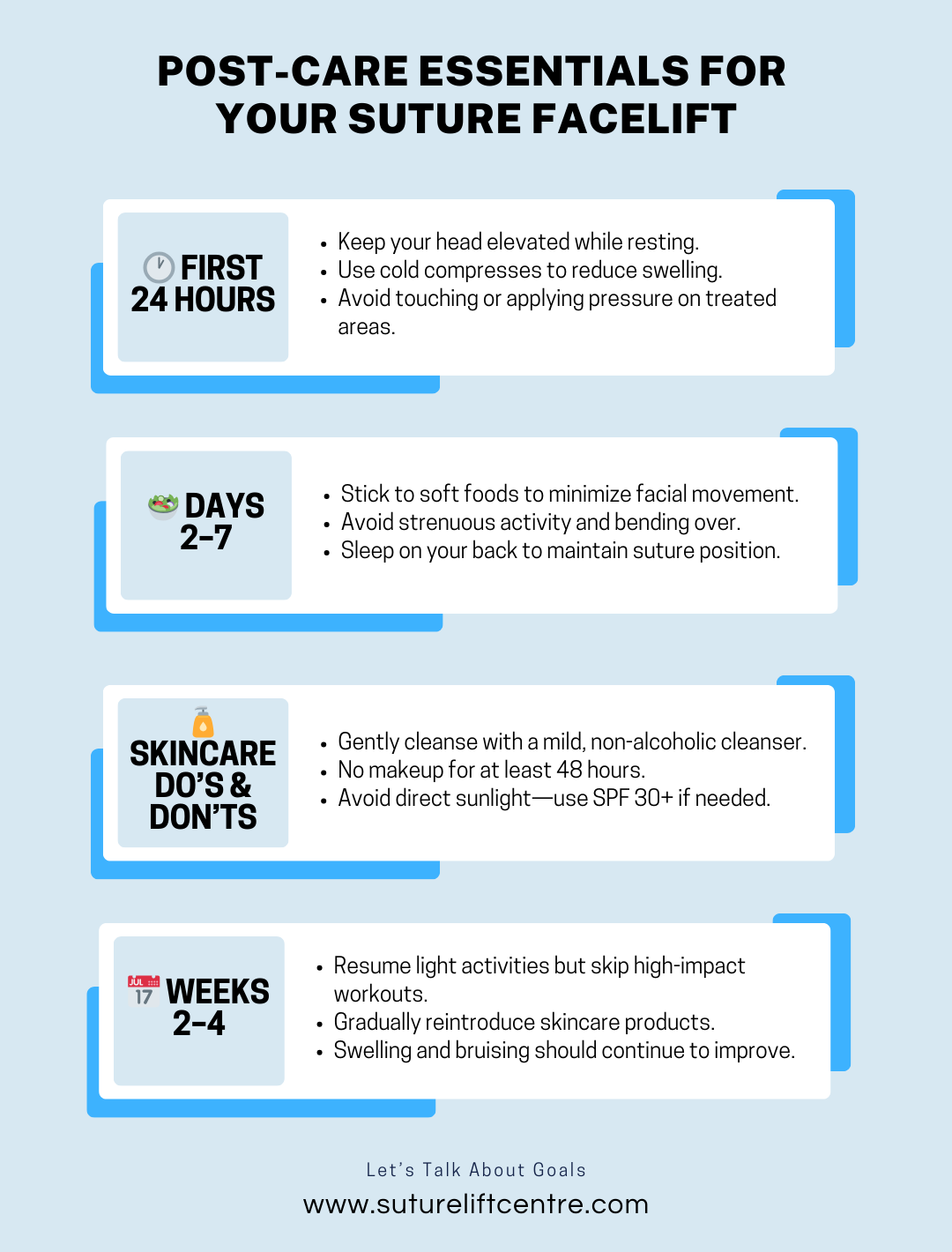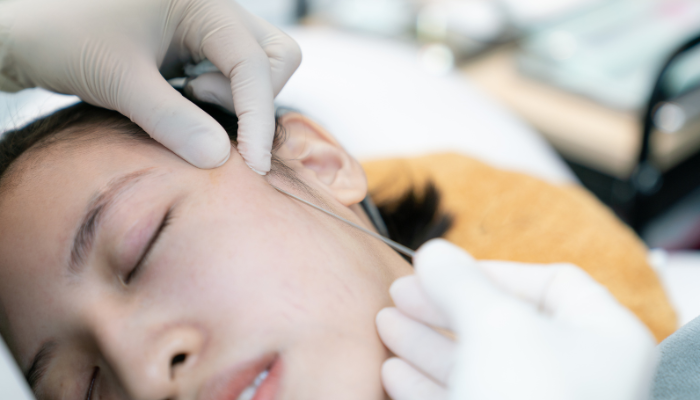What if you could lift and refresh your face—without major surgery? That’s the promise behind a suture facelift, one of the beauty world’s best-kept secrets. This minimally invasive procedure has been quietly gaining popularity among those who want a lifted, more youthful look, but aren’t quite ready for surgery.
So what’s the real story behind these “invisible” threads that promise visible results? In this post, we’re breaking down exactly what a suture facelift is, why people are turning to it, and what you need to know before considering it yourself.
Key Takeaways
- A suture facelift is a minimally invasive procedure that uses special threads to lift and contour the skin.
- It offers long-lasting, natural-looking results, making it ideal for those seeking subtle enhancements.
- Perfect candidates are typically those with mild to moderate sagging who prefer to avoid invasive surgery.
- Preparation involves a consultation to discuss goals and expectations before the procedure.
- Post-procedure care is vital for managing any discomfort and ensuring a smooth recovery.
Understanding Suture Facelifts

What Is A Suture Facelift?
A suture facelift is a minimally invasive procedure designed to lift and contour the skin without the extensive surgery of a traditional facelift. It’s a fantastic option if you’re seeing early signs of sagging and want a refreshed look without significant downtime.
It’s all about enhancing what you already have, not drastically changing it. Suture lifts are permanent, offering a lasting solution to facial rejuvenation.
How Does The Procedure Work?
Special medical-grade threads are inserted beneath the skin to lift and support sagging tissues. These sutures have tiny barbs or cones that grip the skin, allowing the aesthetician to gently lift and reposition the skin.
The procedure is performed using local anaesthetic, so it’s relatively comfortable. The sutures also stimulate collagen production, which helps to improve skin firmness and elasticity over time. This dual action provides both an immediate lift and long-term skin benefits.
Who Is An Ideal Candidate?
So, who is the ideal candidate for a suture facelift? Generally, it’s someone who’s experiencing mild to moderate sagging in the face and neck. You might be noticing a bit of a loss of definition or some early jowling.
It’s also a good option if you’re in relatively good health and have realistic expectations about what the procedure can achieve.
A suture facelift offers a fantastic solution for those seeking subtle yet effective facial rejuvenation. It’s a great way to address early signs of ageing and achieve a more youthful, refreshed appearance with minimal disruption to your daily life. It’s all about enhancing your natural beauty and helping you feel more confident in your own skin.
Benefits Of A Suture Facelift
Minimally Invasive Approach
One of the biggest draws of a suture facelift is that it’s minimally invasive. Unlike traditional facelifts, which involve larger incisions and more extensive surgery, a suture facelift uses small entry points. This means less trauma to the skin and underlying tissues.
- Reduced risk of scarring
- Less post-operative discomfort
- Faster healing times
This approach makes it a great option for patients who want to refresh their appearance without the risks and downtime associated with more invasive procedures.
Quick Recovery Time
Following on from the minimally invasive nature, the recovery time after a suture facelift is generally much quicker than with traditional surgery. Most patients can return to their normal activities within a few days.
There’s typically less swelling and bruising, which means you can get back to your life sooner.
- Reduced downtime compared to traditional facelifts
- Less need for strong pain medication
- Faster return to work and social activities
Natural-Looking Results
Suture facelifts are designed to provide subtle, natural-looking enhancements. The goal isn’t to dramatically alter your appearance, but rather to gently lift and rejuvenate your features.
This results in a refreshed and more youthful look without appearing ‘overdone’.
- Subtle and refined enhancements
- Preservation of natural facial expressions
- Avoidance of a ‘pulled’ or artificial appearance
Comparing Suture Facelifts And Thread Lifts
When considering facial rejuvenation, it’s easy to get lost in the jargon. Two popular options, suture facelifts and thread lifts, both aim to lift and tighten skin, but they achieve this in different ways.
Let’s break down the key differences to help you decide which might be right for you.
Key Differences Between The Two
The main difference lies in the longevity and invasiveness of the procedures. Suture facelifts offer a more permanent solution, while thread lifts provide temporary results. A suture facelift involves carefully placed sutures beneath the skin to lift and support tissues, offering a lasting lift.
Thread lifts, on the other hand, use threads that dissolve over time, meaning the lift is temporary. Suture lifts are more invasive than thread lifts, but the results are more dramatic and long-lasting.
Longevity Of Results
When it comes to how long the results last, suture facelifts have a clear advantage. Here’s a quick comparison:
- Suture Facelift: Results can last for several years, often five years or more, as the sutures create a lasting support structure under the skin.
- Thread Lift: Results typically last from six months to two years, as the threads gradually dissolve and the skin returns to its original position.
- Maintenance: Suture facelifts generally require less frequent touch-ups compared to thread lifts.
Choosing between the two depends on your desired outcome and commitment to maintaining the results. If you’re looking for a long-term solution, a suture facelift is the better option. If you prefer a less invasive procedure with temporary results, a thread lift might be more suitable.
Choosing The Right Option For You
Deciding between a suture facelift and a thread lift depends on several factors, including your goals, budget, and tolerance for downtime. Consider these points:
- Desired Outcome: Are you looking for a subtle lift or a more noticeable change?
- Budget: Suture facelifts are generally more expensive than thread lifts.
- Downtime: Thread lifts typically involve less downtime than suture facelifts.
- Skin Laxity: Suture facelifts are better suited for patients with more significant skin laxity.
Ultimately, the best way to determine which procedure is right for you is to consult with a qualified and experienced practitioner. They can assess your individual needs and recommend the most appropriate treatment plan.
Post-Procedure Care For Suture Facelifts

Managing Discomfort
It’s normal to experience some mild discomfort, swelling, and bruising. Don’t stress; it’s all part of the process.
- Pain Relief: Over-the-counter pain relievers like paracetamol or ibuprofen usually do the trick. Just stick to the recommended dosage. If the pain is a bit much, give us a ring; we might prescribe something stronger.
- Cold Compresses: These are your best mates for the first few days. Apply them gently to the treated area for about 15-20 minutes at a time, several times a day. They help reduce swelling and bruising.
- Sleeping Position: Prop yourself up with a couple of pillows when you sleep. This helps minimise swelling.
Remember, everyone’s different. Some patients breeze through recovery, while others need a bit more TLC. Listen to your body and don’t push yourself too hard.
Ensuring Optimal Healing
To make sure you heal up nicely after your suture facelift, there are a few things you should keep in mind. Following these steps will help you get the best possible results from your procedure.
- Keep it Clean: Gently clean the incision sites as instructed. Usually, this involves a mild cleanser and patting the area dry. Avoid harsh scrubbing.
- Sun Protection: Sun is a no-go for a while. Wear a hat and slap on some high-SPF sunscreen if you’re heading outdoors. UV rays can mess with healing and cause pigmentation.
- Avoid Strenuous Activity: Take it easy for a couple of weeks. No heavy lifting, intense workouts, or anything that gets your heart rate pumping too much.
Follow-Up Consultations
Follow-up appointments are super important. We need to check how you’re healing and make sure everything’s on track.
- Scheduled Check-Ins: We’ll book you in for a few follow-up appointments in the weeks after your procedure. Don’t skip them!
- Address Concerns: This is your chance to ask any questions or voice any concerns you might have. No question is too silly.
- Adjustments if Needed: In rare cases, we might need to make minor adjustments to the sutures. This is usually a quick and easy fix.
| Appointment Type | Timing | Purpose |
|---|---|---|
| Initial Post-Op Check-Up | 1 Week After Procedure | Assess healing, address immediate concerns |
| Follow-Up Appointment | 4-6 Weeks After Procedure | Evaluate results, ensure proper suture placement, discuss long-term care |
| Final Review | 3-6 Months After Procedure | Final assessment of results, address any remaining issues |
We’re here to support you every step of the way. If you have any worries or notice anything unusual, don’t hesitate to get in touch. We want to make sure you’re happy with your results and feeling great!
Safety Considerations For Suture Facelifts
Any cosmetic procedure comes with potential risks, and suture facelifts are no exception. It’s not about scaring you, but about making sure you’re clued up. Common side effects can include some swelling, bruising, and discomfort immediately after the procedure.
These usually settle down within a week or so. Infection is a possibility, though rare, and is usually easily treated with antibiotics.
More rarely, patients might experience suture extrusion (where the suture pokes through the skin), visible sutures, or asymmetry. These issues can often be corrected, but it’s important to be aware of them. The key is to choose a skilled and experienced practitioner who can minimise these risks.
Importance Of A Qualified Practitioner
Seriously, this can’t be stressed enough. Your face is not the place for bargain-basement deals or inexperienced hands. A qualified practitioner will have a thorough understanding of facial anatomy, the correct suture placement techniques, and how to manage any complications that might arise.
Here’s why it matters:
- Minimised Risks: Experienced practitioners know how to avoid damaging nerves or blood vessels.
- Natural Results: They understand facial aesthetics and can create a balanced, natural-looking lift.
- Complication Management: They’re equipped to deal with any issues that might occur during or after the procedure.
Choosing a certified surgeon isn’t just about getting the procedure done; it’s about ensuring your safety and achieving the best possible outcome. Don’t be afraid to ask about their qualifications, experience, and before-and-after photos.
What To Expect During Recovery
The recovery period is generally pretty quick compared to a traditional facelift, but it’s still important to take care of yourself.
Here’s a rough timeline:
- First Few Days: Expect some swelling, bruising, and mild discomfort. Painkillers can help. Avoid strenuous activity.
- First Week: Most of the swelling and bruising should start to subside. You can usually return to work, but avoid heavy lifting or intense exercise.
- First Month: Continue to avoid strenuous activity. You might feel some tightness or pulling sensations, but these should gradually disappear.
It’s important to follow your practitioner’s aftercare instructions carefully. This might include:
- Applying cold compresses to reduce swelling.
- Taking prescribed medications as directed.
- Avoiding excessive sun exposure.
- Sleeping on your back to avoid putting pressure on the sutures.
If you experience any unusual symptoms, such as excessive pain, redness, or discharge, contact your practitioner immediately. Remember, a smooth recovery is key to achieving the best possible results from your suture facelift.
Exploring The Role Of Certified Surgeons
Why Choose A Certified Surgeon?
When you’re considering a suture facelift, it’s easy to get caught up in the promises of quick fixes and amazing transformations. But here’s the thing: your face is precious, and you want to make sure you’re in the safest hands possible. That’s where certified surgeons come in.
Choosing a certified surgeon is about more than just getting the procedure done; it’s about ensuring your safety and getting the best possible results.
Think of it this way: certification means they’ve gone through rigorous training and have proven their competence. They’ve spent years honing their skills and understanding the intricacies of facial anatomy. Plus, certified surgeons are held to higher ethical standards, so you can trust that they have your best interests at heart.
Evaluating Surgeon Credentials
How do you actually check their credentials? It’s not always as straightforward as it seems. First off, look for board certification from a reputable medical board. This means they’ve passed exams and met specific requirements to demonstrate their knowledge and skills.
Don’t be afraid to ask questions. A good surgeon will be happy to explain their qualifications and experience. You can also check online databases to verify their credentials and see if there have been any disciplinary actions against them. It’s all about doing your homework and making sure you’re making an informed decision. Here’s a quick checklist:
- Check for board certification.
- Ask about their training and experience with suture facelifts.
- Verify their credentials online.
- Look for any disciplinary actions.
Patient Reviews And Testimonials
Patient reviews and testimonials can be a goldmine of information when you’re trying to choose a surgeon. They give you a real-world perspective on what it’s like to be a patient of that surgeon. Reading about other people’s experiences can help you get a sense of the surgeon’s bedside manner, their attention to detail, and the overall quality of their work.
Not every review is going to be accurate or unbiased. But if you see a consistent pattern of positive or negative feedback, that can be a valuable clue. Look for reviews that are specific and detailed, rather than just generic praise or complaints. And remember, a good surgeon will have a mix of reviews, because no one can please everyone all the time.
Choosing the right surgeon is a big decision, and it’s worth taking the time to do your research. Don’t be afraid to ask questions, check credentials, and read reviews. Your face will thank you for it!
Conclusion
Choosing how to care for your face is a personal decision—and understanding your options is the first step to makin
g the right one. Suture facelifts offer a less invasive path to looking refreshed, but like any cosmetic procedure, they come with their own considerations. That’s why it’s so important to stay informed, ask questions, and consult with qualified professionals.
If you’re thinking about a suture facelift, don’t just follow trends—follow the facts. Do your research, listen to your body, and choose what aligns best with your goals and comfort level. When it comes to your face, confidence starts with clarity—and you deserve both.
Frequently Asked Questions
What exactly is a suture facelift?
A suture facelift is a non-surgical procedure that uses special threads to lift and tighten the skin, giving a more youthful appearance without major surgery.
How does the suture facelift procedure work?
During the procedure, small threads are inserted under the skin to lift sagging areas. These threads have tiny barbs that grip the skin, allowing for a gentle lift.
Who is a good candidate for a suture facelift?
Ideal candidates are usually those with mild to moderate sagging in their skin, looking for a subtle lift without the need for invasive surgery.
What are the benefits of a suture facelift?
Benefits include minimal invasiveness, quick recovery time, and natural-looking results that can enhance your appearance without drastic changes.
How long do the results from a suture facelift last?
Results from a suture facelift are long-lasting, often providing benefits for several years, as the threads also stimulate collagen production in the skin.
Is the suture facelift safe?
Yes, when performed by a qualified practitioner, a suture facelift is generally safe, but like any procedure, it carries some risks that should be discussed during a consultation.




